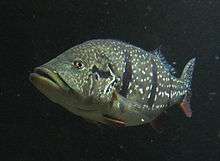Cichla temensis
Cichla temensis, the speckled pavon, speckled peacock bass, painted pavon, or three-barred peacock bass, is a very large South American cichlid, and a prized food and game fish. Reaching up to 1 m (3.3 ft) in length and 13 kg (29 lb) in weight, it is the largest cichlid of the Americas, and perhaps the largest extant cichlid in the world,[1] with only Tanganyika's giant cichlid, Boulengerochromis microlepis, reaching similar proportions.[2]
| Cichla temensis | |
|---|---|
 | |
.jpg) | |
| Adult above, juvenile below | |
| Scientific classification | |
| Kingdom: | Animalia |
| Phylum: | Chordata |
| Class: | Actinopterygii |
| Order: | Cichliformes |
| Family: | Cichlidae |
| Genus: | Cichla |
| Species: | C. temensis |
| Binomial name | |
| Cichla temensis Humboldt, 1821 | |
Range
C. temensis is native to the Orinoco and Rio Negro basins, as well as several smaller rivers in the central Amazon (Uatumã, Preto da Eva, Puraquequara, and Tefé), in Brazil, Venezuela and Guyana.[3][4] In its native range, it is essentially restricted to blackwater rivers and their tributaries.[4]
Introduction attempts have been made outside its native range, but it has not managed to become established in Florida or Texas.[5] In contrast, it has flourished in tropical Singapore.[6]
Appearance

C. temensis resembles other peacock bass species, but is generally more elongated and slender in shape.[4] Adults are highly variable in colour pattern, which has historically caused some problems, with some speculating that the variants were separate species or males/females.[7] Only in 2012 was it firmly established that dark individuals with a dense light-speckled pattern are the nonbreeders, while breeding adults are more golden-olive and lack the pale speckles, but have three broad, dark bars on their bodies.[7] During the breeding season, some males also develop a bulbous forehead. Between the two extremes are several intermediate patterns.[7] No other peacock bass species is known to have such extreme variations among the adults.[7]
References
- Reis, P. (2015), Aspects of life history of Cichla temensis (Perciformes: Cichlidae) and its relationship to the Amazon basin's flood pulse, Rutgers University
- "The 10 biggest cichlids". Practical Fishkeeping. 13 June 2016. Retrieved 17 October 2017.
- Froese, Rainer and Pauly, Daniel, eds. (2017). "Cichla temensis" in FishBase. October 2017 version.
- Kullander, Sven; Efrem Ferreira (2006). "A review of the South American cichlid genus Cichla, with descriptions of nine new species (Teleostei: Cichlidae)". Ichthyological Explorations of Freshwaters. 17 (4).
- Nico, L. (2011). Cichla temensis. USGS Nonindigenous Aquatic Species Database, Gainesville, FL
- "Peacock Bass (introduced)". Ecology Asia. Retrieved 17 October 2017.
- Reiss, P.; K.W. Able; M.S. Nunes; and T. Hrbek (2012). "Color pattern variation in Cichla temensis (Perciformes: Cichlidae): resolution based on morphological, molecular, and reproductive data". Neotrop. Ichthyol. 10 (1). doi:10.1590/S1679-62252012000100006.CS1 maint: uses authors parameter (link)
| Wikimedia Commons has media related to Cichla temensis. |